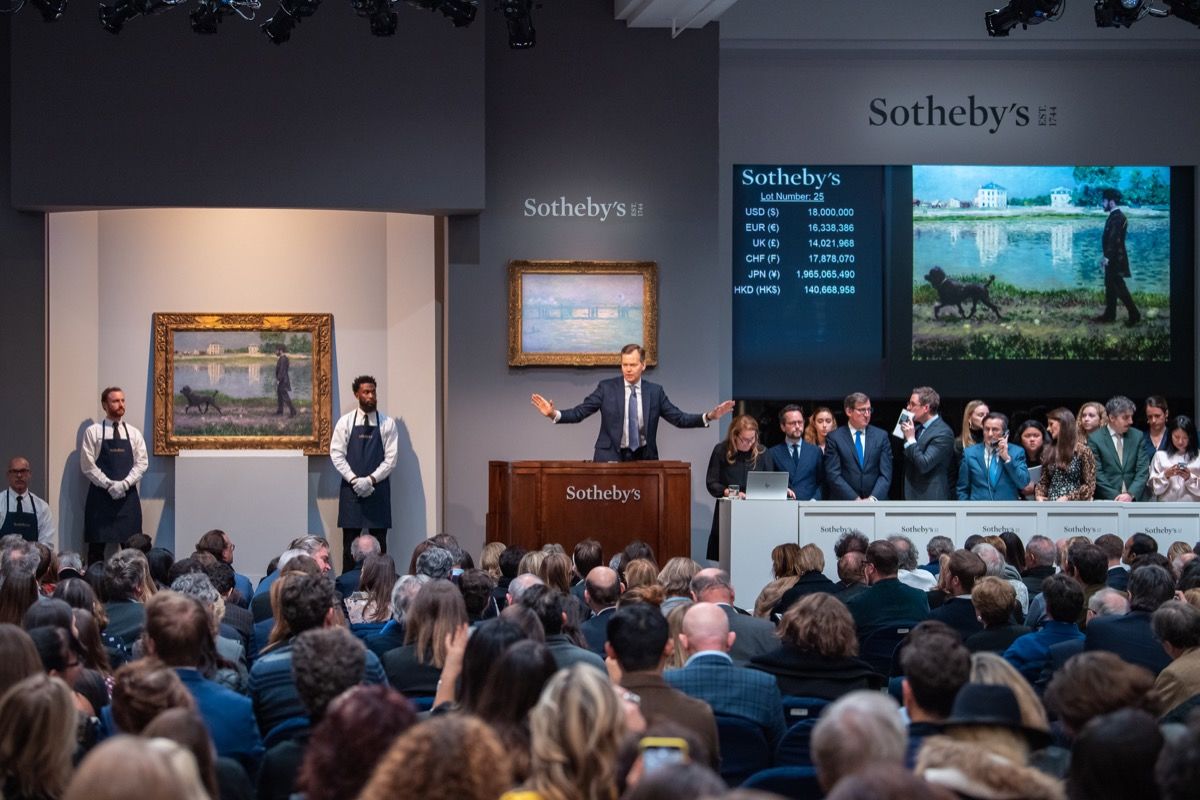
I Thought I Knew the Art World—Then I Went to My First Auction
Attending my first auction last week, I found myself looking at a group of Sotheby’s
employees talking to one another across a large room, ears pressed to black receivers.At the auction of contemporary art at Sotheby’s last Thursday night, I expected spectacle and lots of paddle-raising. Instead, I watched people talk on the telephone for about an hour and a half, without hearing anything they were saying. Art swivelled on a rotating platform behind the auctioneer, Oliver Barker.
’s Roxbury Front (1965), a mobile colored red, black, and white, floated above the auction attendees, who sat on folding chairs and hardly raised a hand the whole time. The experience left me with more questions than answers, mystified as ever by the inner workings of the art market.
As an art writer, I’ve been lucky enough to cover many facets of the art world: I profile artists, attend fairs, and speak to gallerists, curators, academics, and other museum staff on a regular basis. Auction attendance seemed like the last major box to tick, a final component of the art world that would help me better understand how the entire machinery functions. Instead, I learned how the most lucrative cog in the wheel conducts its business in public, while keeping the most significant information private. At Sotheby’s, I observed a mannered performance with its own codes and rituals as the auction house sold $270.6 million worth of art. While I “watched” the auction unfold, the most important components of the whole event remained invisible to me, a novice market reporter.
Many aspects of the auction functioned as I expected: Barker announced, one by one, the lots on offer. During protracted bidding contests, he called out dollar amounts, starting slightly below the works’ low estimates. He looked around the room for any takers, clenching the sides of the podium and leaning out toward the audience and the specialists. He called out bids as he spotted interested parties. Barker gave warnings when bidding seemed to stall near an acceptable dollar value, then struck his wooden podium with a gavel to note a winning bid. Bidding values in euros, yen, pounds, Swiss francs, and U.S. and Hong Kong dollars flashed on a black screen at the front of the room. They generally rose in increments of $50,000 or $100,000.
One of the most satisfying parts of the whole experience was filling out a score sheet of sorts that Sotheby’s publicists helpfully handed out. The grid featured the artwork titles, low and high estimates, and previous auction records for the artists. I saw many people throughout the audience marking their own small booklets with the auction results. As my sheet filled, a story in numbers began to appear. The practice yielded the same pleasures that, I assume, baseball scoring does: It’s a way to organize and form a narrative from rapid-fire information.
If these sheets helped clarify what was going on, the number of phone bids kept the auction mysterious to me. Most of the bidders were calling auction specialists, who raised their own hands to signal a bid. Sometimes, two Sotheby’s staff members, standing right next to each other, would bid on the same lot. Barker would speak to each of them as they bid against each other, then they’d speak into their phones to apprise their clients of the situation. The whole thing, from an outside perspective, looked like a Sotheby’s office party we’d been invited to watch from the sidelines. Voyeurism is integral to the ritual. I wondered why this auction, and this crowd, was even necessary—these auction specialists seemed to be figuring everything out amongst themselves just fine.
I was particularly curious about this large crowd of people who’d come to the sale. Very few attendees appeared to be bidding on the art.
“Sometimes the call’s coming from inside the room,” a friend whispered to me. That piece of advice, which sounded more like a horror movie trope than guidance for watching an auction, gave me a new perspective. I scanned the seats in front of me, trying to scope out who was on the phone. The most experienced auction reporters, I learned, can tell certain dealers from the backs of their heads. They’ve memorized David Zwirner’s and Robert Mnuchin’s haircuts. They can also make educated guesses about the collectors behind the phone bids, given the nationality of the specialists; if a Japanese Sotheby’s specialist wins a lot, the collector on the line is probably Japanese. To truly understand what’s going on during an auction, you need more than a completed scoring sheet: You need a keen knowledge of everyone around you—and their possible phone dates. The true story of an auction is both in the numbers, and in the people and conversations that remain mostly hidden from view.
In contrast to the clarity of the pricing on the screen, the buyers’ identities remain totally unclear to me. It’s nearly impossible to prove someone bought a work at auction unless it comes up for public view, and even then, it can do so anonymously. The auction sparked my curiosity as it deepened my understanding of forces that shape sales and stories about the art world. More importantly, for me at least, was the chance to see masterful artworks byWayne Thieband